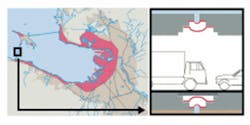Sealed for Your Protection
By Gwladys Foucheacute;
Trelleborg AB’s giant seals help protect St. Petersburg, Russia, from flooding
St. Petersburg is regarded as Russia’s cultural capital. To protect its people and cultural treasures from flooding, a 25-km storm flood barrier is being constructed. An essential part of this structure is 40 meter-wide, seven meter-high seals from Trelleborg.
Last January, the city was flooded for the 302nd time in its 303-year history. The water level rose more than two meters above normal, flooding some of the streets bordering the waterfront.
St. Petersburg is situated at the point where the Neva River flows into the Gulf of Finland, so when strong winds in the gulf blow eastward, they act as a barrier against the Neva flowing westward. As a result, the waters can rise in only a few hours, threatening St. Petersburg’s 4.6 million people and its priceless historical sites, such as the world-renowned Hermitage Museum.
In 1979, the Soviets began construction of a storm flood barrier across the Gulf of Finland, but the project had to be abandoned a few years later for financial reasons as the demise of the Soviet Union began. In 2003, however, Russian President Vladimir Putin, a native of St. Petersburg, ordered the project to restart and it’s now supported by the European Bank for Reconstruction & Development.
The storm flood barrier consists of a 25-km dam, six discharge sluices and two navigation channels. The main channel is 200 meters wide and will be sealed using two 130m curved doors. These amazing structures will normally rest in curved dry-docks on either side of the channel. When needed, the docks will be flooded and the doors floated to closure. As the barrier will be part of the ring road around the city, a tunnel, 17 meters under the flood gates, has been designed to pass under the main channel.
In the 1980s, all 15 tunnel sections were constructed without being connected. “Our contribution is the design of a sealing system that connects the tunnel sections. We are more or less supplying the missing links,” says Erwin Brakenhoff, sales director at Trelleborg Bakker – a part of Trelleborg Engineered Systems, which is a business unit of Trelleborg AB of Sweden.
“The seals are sufficiently resistant that they will protect the tunnel from water gushing in under high pressure,” explains Vladimir Vasilijev, Trelleborg Bakker’s area sales manager in Moscow. “At the same time, they are flexible enough to allow movement by the tunnel sections.”
It was essential that the 40m-wide, 7m-high seals, were made to the highest standards of quality. They’re called Omega because they’re the shape of the Greek letter. “Once the seals are laid, it is impossible to go in and repair them. These seals are made to provide resistance for the next hundred years,” says Vasilijev.
The seals were manufactured in the Netherlands, at Trelleborg Bakker’s factory in Ridderkerk, outside Rotterdam. Construction of the St. Petersburg dam is scheduled to finish in 2008. So January’s flood may hopefully turn out to be the last in St. Petersburg’s history.
This is the first time Omega seals were used in a tunnel of the type being built in St. Petersburg, which is a “cut-and-cover” tunnel, whereby a hole is dug, the tunnel constructed bit by bit, and then its covered with sand. What’s also unique is that the tunnel will be provided with a double sealing system, an outer Omega seal and an inner one, as a back-up. Omega seals can withstand high water pressure in combination with relatively large displacements in all three directions. They can also withstand temperatures ranging from minus 30°C to plus 70°C.
WWi
Author’s Note:
Gwladys Foucheacute; is a writer for Minett Media (www.minett.com), an independent editorial production and global placement agency, focusing on b2b projects.
Founded in 1905, Sweden’s Trelleborg AB is a global industrial group and leader in advanced polymer technology for high performance sealing solutions. Contact: www.trelleborg.com/bakker/


